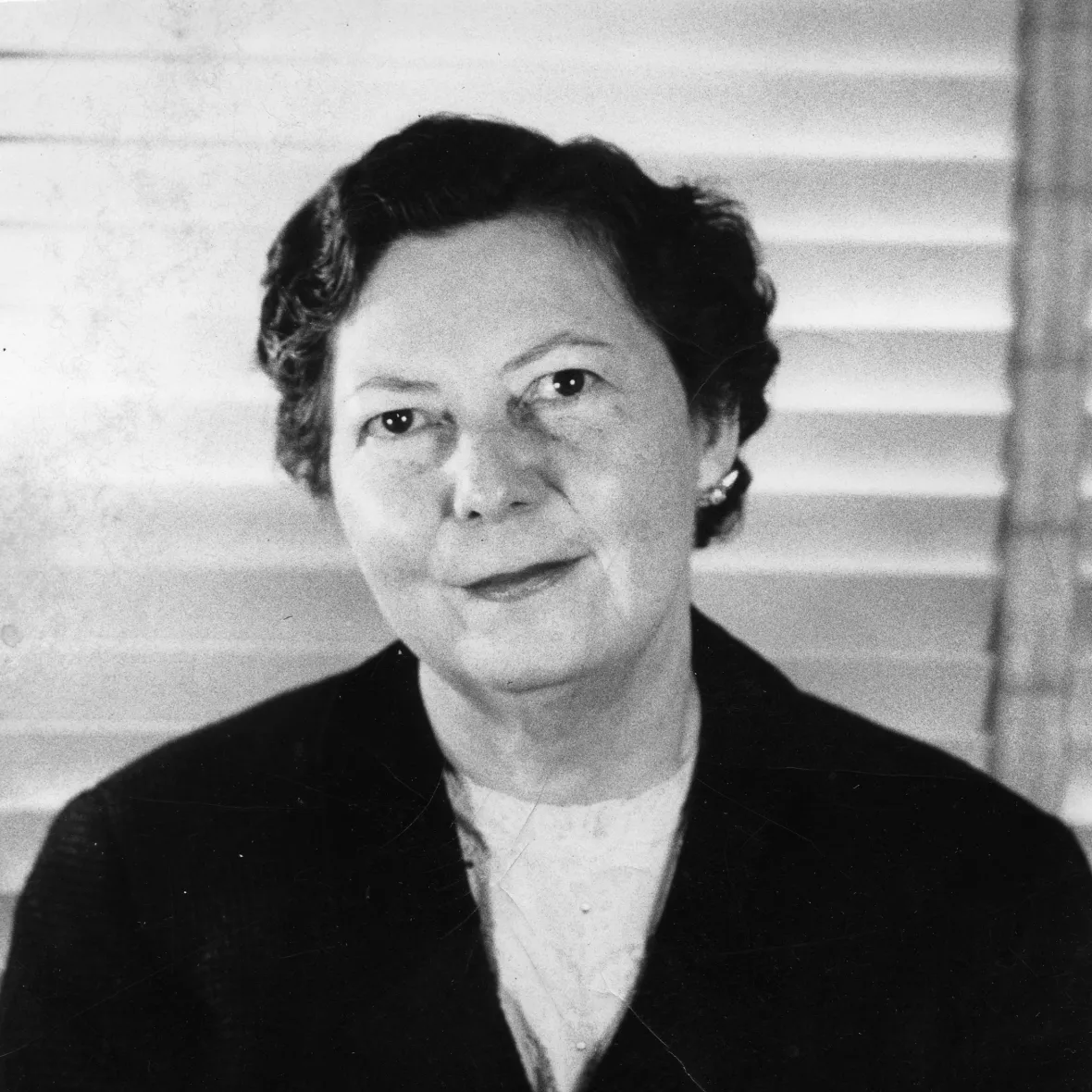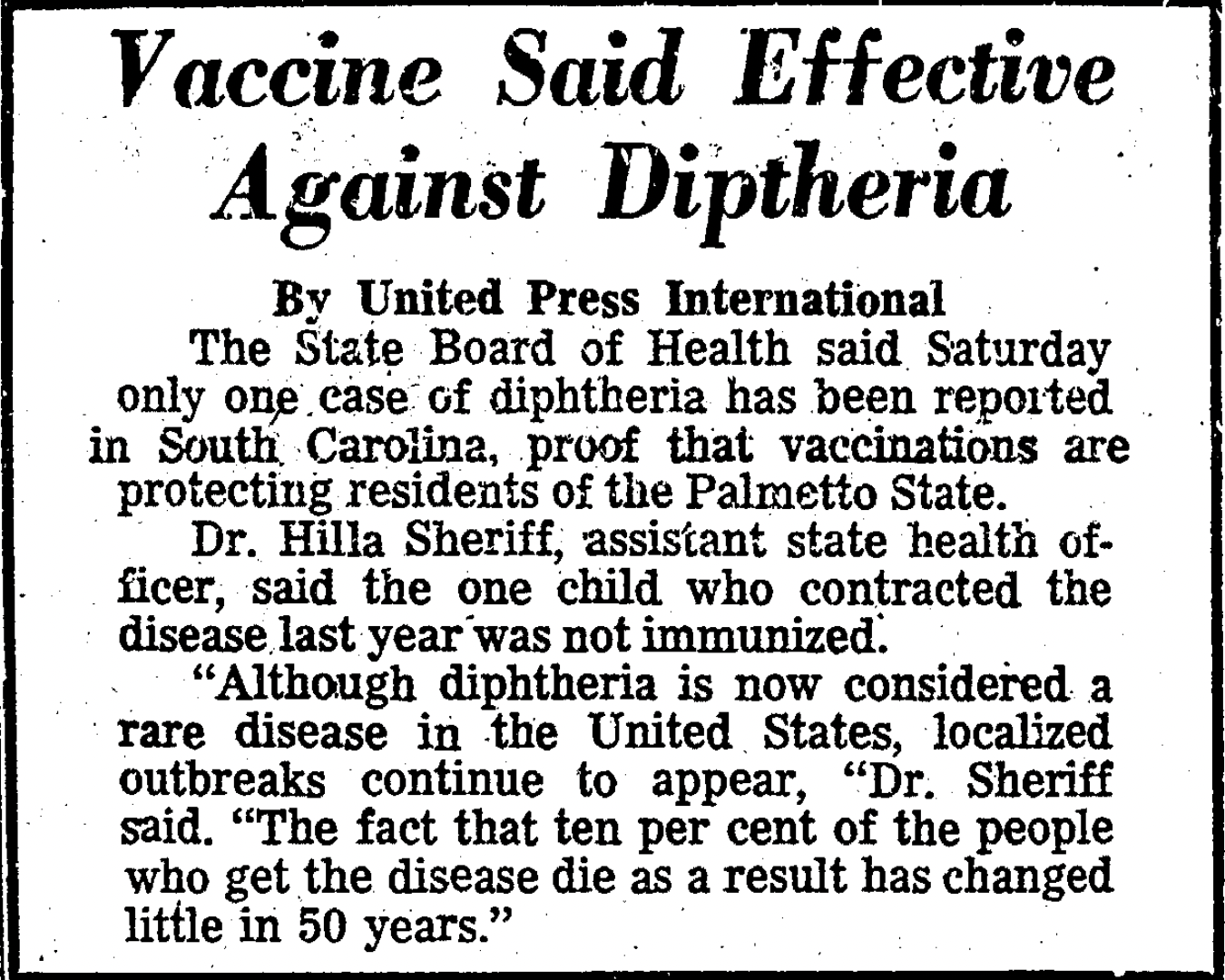 View All Honorees
View All Honorees
Columbia City of Women Honoree
Hilla Sheriff, MD
Dr. Hilla Sheriff, 1960s. Image courtesy Hilla Sheriff papers, South Caroliniana Library, University of South Carolina, Columbia
I was attracted to public health because of the need. The terrible need. And I stayed in it because it was so rewarding to see the effects of our work. We saw pellagra nearly wiped out, maternal and infant mortality rates drop. We knew we were making progress.
-Hilla Sheriff, The State, February 16, 1986
Over the course of 45 years, Dr. Hilla Sheriff became an internationally recognized leader in the fields of maternal and child healthcare. What started out as a volunteer position in public health with Spartanburg County in 1929—”Frankly, I didn’t have enough to do”—quickly became the beginning of a career in public service instituting and lobbying for policies that impact the state today.
Born in 1903 in Easley and raised in Orangeburg, Sheriff attended the College of Charleston and the Medical College of the State of South Carolina, where she received her medical degree in 1926. After completing an internship at the Hospital of the Women’s Medical College of Pennsylvania and residencies in Washington DC and New York, Sheriff returned to her native South Carolina to establish her own private pediatrics practice. What started out as a volunteer position became, by 1929, a paid position as the first female county health official in South Carolina. During the Great Depression she travelled to mill villages and farms treating diseases, especially pellagra, which was the second-leading cause of death in South Carolina at the time. A nutritional disorder caused by a lack of Vitamin B3, pellagra primarily afflicted women and children as they were the last in the family to eat during periods of poverty.
In 1931, Sheriff became the director of the American Women’s Hospitals (AWH) Domestic Program in Spartanburg. She directed AWH resources towards the eradication of pellagra, diphtheria, typhoid, and tuberculosis—all of which were prevalent among poor and marginalized communities. To do this, the AWH partnered with county officials to perform community outreach, education, and treatment, at times taking the clinic to individuals through the AWH’s “healthmobile,” a wagon attached to a Model A Ford.

In addition to treating diseases, Sheriff focused on family planning services as a means of lowering the maternal death rate. She studied the effectiveness of low-cost products including spermicidal jellies and diaphragms that could be easily transported and that women could control. Her research supported a national scientific movement seeking to overturn outdated statutes banning contraceptive education and devices. The popularity of Sheriff’s model for family planning at her county clinic led to the creation of similar clinics throughout the state in 1936. Three years later, South Carolina became the second state in the nation to make birth control one of its official public health services—a feat covered by Life magazine in 1940. The following year, due in large part to the newly-established network of family planning clinics, statewide campaigns to train midwives, and the treatment of venereal diseases, maternal and infant death rates fell by 25%.
In 1940, Sheriff became the state’s first female public health officer. Her work with the State Department of Health’s Division of Maternal and Child Health, first as assistant director and then as director from 1941-1967, took her previous efforts and implemented them statewide. Under her supervision, the state established children’s health clinics to provide vaccines for young people from common diseases, and Sheriff regularly lent her name and expertise to local news reports extolling the virtues of everything from vaccinations to seatbelts to childproofing homes during the holiday season.

From her office in Columbia, Sheriff developed the first premature nursery in a South Carolina hospital and opened the state’s first maternity shelter. Sheriff also successfully lobbied for the licensing of midwives, who played an essential role in healthcare. As late as 1941, nearly half of South Carolina’s births occurred at home, and despite having “a greater reduction of maternal mortality in South Carolina than any other state,” the state still had the nation’s highest maternal mortality rate. Sheriff argued that, “although the midwife is not an ideal attendant at deliveries,” given the shortage of physicians in the state, developing a system for training them was the best solution. According to one of her many award nominations, “Doctor Sheriff was responsible for standard setting and raising of maternal and child health infant care for more than four decades.”


Sheriff continued to administer programs for women and children until 1967, when she was promoted to deputy commissioner of the State Board of Health and chief of the Bureau of Community Health Services.
Late in her career, Sheriff focused state resources on poison control, accident prevention, and led efforts to pass a state law requiring physicians to report cases of suspected child abuse. In 1968, she successfully lobbied for the consolidation of country health departments into state health districts, which still exist today. Even after her retirement in 1974, she continued to lobby for stronger laws to protect battered children. Hilla Sheriff died in 1988.
Selected References:
Allen, Katharine, and West, Elizabeth. “A Gospel of Health: Hilla Sheriff's Crusade Against
Malnutrition in South Carolina,” (University Libraries, University of South Carolina, 2011).
Hill, Patricia Evridge. “Go Tell It on the Mountain: Hilla Sheriff and Public Health in the
South Carolina Piedmont, 1929 to 1940,” American Journal of Public Health, Vol. 85, No. 4, April 1995.
Hilla Sheriff papers, South Caroliniana Library, University of South Carolina, Columbia
“Hilla Sheriff: Public Health Pioneer,” Opening Doors: Women at the Medical
University of South Carolina, MUSC Library. http://waring.library.musc.edu/exhibits/MUSCwomen/Sheriff.php
“Report of the Committee on Maternal and Infant Welfare,” Journal of the South Carolina Medical Association,
April 1943. “The More I Did, The More I Saw the Need,” State (Columbia), February 16, 1986.
From 1941 until 1967, Sheriff served as the director of the Division of Maternal and Child Health. From her office in the Wade Hampton Office Building, she developed midwife training programs, gave interviews, and lobbied for public health funding and legislation.